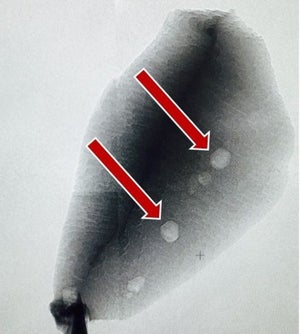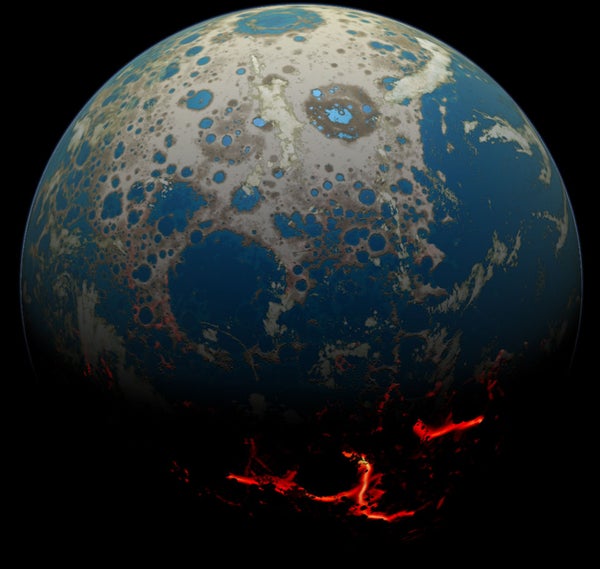This article was published in Scientific American’s former blog network and reflects the views of the author, not necessarily those of Scientific American
Searching for clues to the earliest life on Earth is a tricky business. Very little of the ancient planetary crust remains accessible, with the oldest recovered rock chunks clocking in at an age of somewhere around 3.8 billion years. To add to the problem, it seems unlikely that life consisted of anything but microscopic, single-celled, organisms for at least the first billion years - leaving the barest of geochemical or fossil remains.
However, even older geophysical samples do exist - in the form of tiny crystals of zircon (zirconium silicate) found inside some of the most ancient rocks. Some of these highly resilient grains have been dated to an age of approximately 4.4 billion years via their uranium, thorium, and lead contents. The isotopic ratios of oxygen in zircons also suggest that at least some of these grains interacted with a hydrosphere - evidence of liquid water on a very young Earth.
Now a new study, reported by Bell et al. in the Proceedings of the National Academy of Science, has trawled through over 10,000 tiny zircon crystals in search of the signs of early life. A total of 656 of these zircons were found to contain dark specks, or inclusions. 79 out of those zircons were subjected to more detailed analysis and one 4.1 billion year old zircon was discovered to contain two microscopic bits of graphite - pure carbon.
On supporting science journalism
If you're enjoying this article, consider supporting our award-winning journalism by subscribing. By purchasing a subscription you are helping to ensure the future of impactful stories about the discoveries and ideas shaping our world today.

Carbon inclusions in a 4.1 Gya zircon crystal (Credit: Stanford/UCLA)
Critically, when the researchers measure the carbon isotope ratio of these graphite inclusions they find a significant enhancement of the abundance of the lighter carbon-12 isotope compared to carbon-13. This kind of isotopic bias is generally considered as a smoking gun for biological processes - which tend to preferentially sequester lighter isotopes. In fact the 13C/12C ratio seen in this 4.1 billion year old graphite is a near identical match to that of kerogen deposits across the Earth's rock record, and to the ratio in living microbial organisms.
The tentative conclusion is that these carbon specks could have been incorporated into the forming zircons from a biological source 4.1 billion years ago.
If further research supports this interpretation it'll be a stunning outcome - demonstrating that life existed on Earth barely 400 million years after the planet finished the majority of its hugely violent formative processes.
Except this now runs headlong into the generally accepted picture of what was happening to the Earth, and the solar system between 3.8 and 4.1 billion years ago. Evidence from lunar cratering and rocks retrieved by the Apollo missions, together with data from meteoritic compositions, have suggested that during this time the inner planets were experiencing what's now known as the Late Heavy Bombardment.
This is thought to have been a period of intense asteroid impacts on the Moon and, by extension, the Earth. In fact it's also been seen as a critical piece of the final touch-up to Earth's crust, adding a 'late veneer' of material. The cause of this bombardment has been hypothesized as the literal fallout (or fall-in) of material due to a dynamical reconfiguration of the outer, giant, planets.
Understanding that reconfiguration is in itself an entire field of research, but in essence this dynamical activity could help also explain the present distribution of Kuiper-belt objects and the orbital arrangement of the outer worlds in our solar system.
The problem is that the bombardment of Earth would have been intense, with some estimates suggesting that there were more than 20,000 impact events capable of making craters larger than 20 kilometers across, and several impacts producing 5,000 kilometer craters. In other words, big, bad stuff would have been taking place pretty much every 100 years for about 300 million years.
That could make the Earth's environment a very tough place for life. So finding evidence for life on Earth just prior to this bombardment, and right after, raises some very big questions.
Did this bombardment really happen when we think it did? Or did it take place before the first life?
Could life on Earth have survived through those 300 million years of planetary pummeling?
Or, did life just keep re-starting - re-originating - all through that period until finally the planet stopped killing it off?
We don't have answers to these questions yet, but these tiny carbon specks inside one ancient zircon crystal could prove to be a pivotal discovery in our efforts to understand life's intimate relationship to its cosmic cradle.
